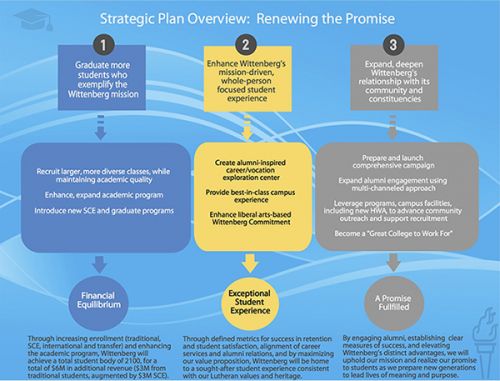Given the current challenges confronting higher education and the ongoing need to ensure Wittenberg's financial equilibrium, the plan defines three key areas of focus.

Goal 1: Graduate more students who exemplify Wittenberg's mission
Strategy A: Recruit and retain larger, more diverse classes to experience a Wittenberg education, reaching 2000 students at the end of plan year 3 (Fall 2020), consistent with the Board vision statement, and 2100 students after plan year 5 (Fall 2022).
- Diversify and expand traditional undergraduate recruitment markets while maintaining the academic quality of incoming classes
- Implement a comprehensive international recruitment strategy
- Expand academic program outreach and recruitment, including department-specific endowed scholarships, first year research fellowship opportunities and special interest awards
- Develop and implement a plan to increase the number of transfer students
- Increase athletic recruitment in targeted sports and add new athletic teams and co-curricular programs co-curricular programs to attract students
- Develop and implement a comprehensive retention plan to achieve at least 80% first-to-second-year retention and a comparable improvement in four-year graduation rate
Strategy B: Enhance the academic program for 21st century learning
Propose two to four new academic programs in high-demand areas (e.g., allied health, sustainability, and digital media)
Invest in established high-demand programs to sustain and expand growth
Expand the general education program to integrate learning goals of intellectual inquiry, global citizenship, communication, vocation and quantitative reasoning, throughout the curriculum at the program, department, and University level
Develop professional experiential learning/shadowing opportunities modeled on the C.A.B.L.E. program for relevant academic programs in two years
Redesign the Honors Program to make the University more attractive to academically talented students
Strategy C: Transition the School of Community Education into a new school of graduate and professional studies that is an incubator for market-ready, mission-aligned graduate programs, achieving $3M in additional net revenue in plan year 5
Transfer M.A. in Education and new M.A. in Coaching to re-imagined SCE to join current M.S. in Analytics program and to centralize operations
Develop additional master's degree programs aligned with market demand and growth potential, and stage their launch appropriately over the next five years
Goal 2: Enhance Wittenberg's mission-driven, whole-person focused, exceptional student experience
Strategy A: Establish a leading and innovative center for career and vocation that engages students and alumni and enables them to thrive in their post-graduate employment, studies, and service
Create seamless and integrated coordination between the new center, alumni relations, and the Hagen Center for Civic and Urban Engagement to expand significantly the number of internships, externships, and vocational exploration opportunities for our students
Secure funding to endow a center for career and vocation and provide leading high impact experiences for our students
Develop a unified approach to programming initiatives and materials that draw upon the Lutheran understanding of vocation
Expand opportunities for alumni to utilize areas of expertise to help mentor students, identify internship and employment opportunities, and to network with each other
Strategy B: Broaden and improve the student experience with campus-wide and cohort-based programming and initiatives
- Develop a comprehensive plan to achieve new levels of student health and well-being with an emphasis on prevention that combines an evidence-based public health approach with innovative engagement strategies
- Provide programming, support, and resources to develop scholar-athletes who will compete on a national level and model the Division III philosophy by: discovering their true callings; developing life, leadership, and academic skills; and dedicating themselves to a life of serving others
- Develop student experience and satisfaction metrics, dashboard, and annual goals that aggregate National Survey of Student Engagement data, co-curricular learning outcomes assessment, campus housing satisfaction surveys, and related measures
Strategy C: Fully implement and market our value proposition, the Wittenberg Commitment, to explain the advantages of a Wittenberg education to prospective students and donors
Assess and enhance the First-Year Full-Year Seminar, expanding its connections to the new general education program
Develop agreed-upon standards, professional development, ongoing support, and assessment strategies for Comprehensive Advising
Significantly expand Engaged Learning opportunities across all programs and across the academic calendar, both as high-impact practices within courses, as well as co-curricular and extra-curricular experiences
Fully deploy the WittFolio to provide state-of-the-art electronic portfolio functionality to all students, not just entering classes
Expand the Wittenberg Network to include all academic departments and units on campus and implement a regular assessment/satisfaction measure and continuous improvement plan
Complete four-year degree pathways for all majors and programs in support of our Graduation Guarantee
Goal 3: Expand, deepen Wittenberg's relationships with its community and constituencies
Strategy A: Prepare and launch a comprehensive campaign
- Plan feasibility study and silent phase to take best advantage of fundraising efforts for Health, Wellness, and Athletic facility
- Expand alumni engagement using multi-channel approach through a new center for career and vocation and Wittenberg Network initiative
- Expand alumni mentorship pilot for first-generation first-year students
- Define and develop a reliable measure for alumni involvement across campus as a complement to the alumni giving rate, establish a baseline, and set goals for annual incremental improvement
Strategy B: Leverage the new Health, Wellness, and Athletic facility and related campus resources to reach new students and forge new ties with local and regional communities
- Develop data collection and long term outreach strategy for participants in youth sports programs and community events held at all athletic facilities
Strategy C: Develop a plan to become a nationally recognized "Great College to Work For" as named by The Chronicle of Higher Education with key criteria that include trust, respect, pride, achievement of organizational objectives, and teamwork

